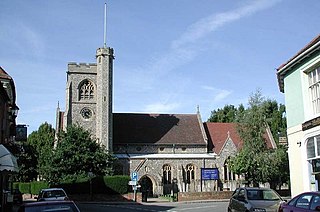
The kingdom of the East Saxons, today referred to as the Kingdom of Essex, was one of the seven traditional kingdoms of the Anglo-Saxon Heptarchy. It was founded in the 6th century and covered the territory later occupied by the counties of Essex, Hertfordshire, Middlesex and Kent. Kings of Essex were frequently subservient to foreign overlords. The last king of Essex was Sigered and in 825, he ceded the kingdom to Ecgberht, King of Wessex.
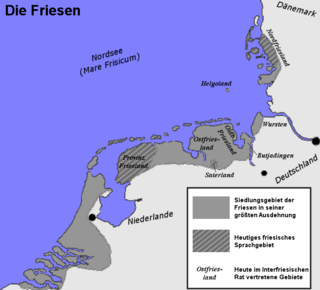
The Frisians are a Germanic ethnic group indigenous to the coastal parts of the Netherlands and northwestern Germany. They inhabit an area known as Frisia and are concentrated in the Dutch provinces of Friesland and Groningen and, in Germany, East Frisia and North Frisia. The Frisian languages are still spoken by more than 500,000 people; West Frisian is officially recognized in the Netherlands, and North Frisian and Saterland Frisian are recognized as regional languages in Germany.
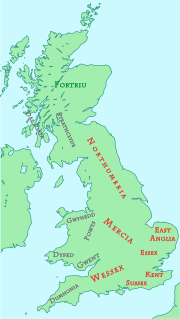
The Kingdom of the South Saxons, today referred to as the Kingdom of Sussex, was one of the seven traditional kingdoms of the Anglo-Saxon Heptarchy. On the south coast of the island of Great Britain, it was originally a sixth century Saxon colony and later an independent kingdom. The South Saxons were ruled by the kings of Sussex until the country was annexed by Wessex, probably in 827, in the aftermath of the Battle of Ellandun.

Dumnonia is the Latinised name for the Brythonic kingdom in Sub-Roman Britain between the late 4th and late 8th centuries, in what is now the more westerly parts of South West England. It was centred in the area later called Devon, but included modern Cornwall and part of Somerset, with its eastern boundary changing over time as the gradual westward expansion of the neighbouring Anglo-Saxon kingdom of Wessex encroached on its territory. The spelling Damnonia is sometimes encountered, but is also used for the land of the Damnonii, later part of the Kingdom of Strathclyde, in what is today southern Scotland. Domnonia also occurs and shares a linguistic relationship with the Breton region of Domnonée, Breton: Domnonea.

Hertfordshire is an English county, founded in the Norse–Saxon wars of the 9th century, and developed through commerce serving London. It is a land-locked county that was several times the seat of Parliament. From origins in brewing and papermaking, through aircraft manufacture, the county has developed a wider range of industry in which pharmaceuticals, financial services and film-making are prominent. Today, with a population slightly over 1 million, Hertfordshire services, industry and commerce dominate the economy, with fewer than 2000 people working in agriculture, forestry and fishing.
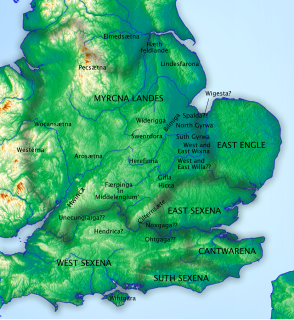
The Tribal Hidage is a list of thirty-five tribes that was compiled in Anglo-Saxon England some time between the 7th and 9th centuries. It includes a number of independent kingdoms and other smaller territories and assigns a number of hides to each one. The list of tribes is headed by Mercia and consists almost exclusively of peoples who lived south of the Humber estuary and territories that surrounded the Mercian kingdom, some of which have never been satisfactorily identified by scholars. The value of 100,000 hides for Wessex is by far the largest: it has been suggested that this was a deliberate exaggeration.
Verlamion, or Verlamio, was a settlement in Iron Age Britain. It was the centre of Tasciovanus' power and a major center of the Catuvellauni from about 20 BC until shortly after the Roman invasion of AD 43. Its location was on Prae Hill, 2 km to the west of modern St Albans.
The Pecsætan, also called Peaklanders or Peakrills in modern English, were an Anglo-Saxon tribe who inhabited the central and northern parts of the Peak District area in England. The area was historically the home of the southern clan of the Brigantes, a Brythonic tribe, before the Anglo-Saxon invasion. The very early Derbyshire settlements, in what is now known as the Peak District, were those of the West Angles. This tribe advanced up the valleys of the rivers Derwent and Dove during their northern conquests in the 6th century. They became known locally as the Pecsætan. Later their territory formed the northern division of Mercia, and in 848 the Mercian Witenagemot assembled at Repton.

The Wreocensæte, sometimes anglicized as the Wrekinsets, were one of the peoples of Anglo-Saxon Britain. Their name approximates to "Wrekin-dwellers". It is also suggested that Wrexham also derived from Wreocensæte.

The Kingdom of the East Angles, today known as the Kingdom of East Anglia, was a small independent kingdom of the Angles comprising what are now the English counties of Norfolk and Suffolk and perhaps the eastern part of the Fens. The kingdom formed in the 6th century in the wake of the Anglo-Saxon settlement of Britain. It was ruled by the Wuffingas in the 7th and 8th centuries, but fell to Mercia in 794, and was conquered by the Danes in 869, forming part of the Danelaw. It was conquered by Edward the Elder and incorporated into the Kingdom of England in 918.
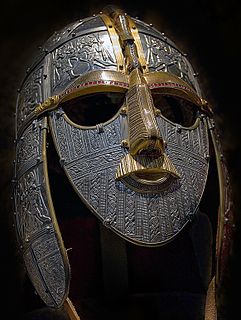
The Anglo-Saxon settlement of Britain describes the process which changed the language and culture of most of what became England from Romano-British to Germanic. The Germanic-speakers in Britain, themselves of diverse origins, eventually developed a common cultural identity as Anglo-Saxons. This process occurred from the mid-fifth to early seventh centuries, following the end of Roman rule in Britain around the year 410. The settlement was followed by the establishment of Anglo-Saxon kingdoms in the south and east of Britain, later followed by the rest of modern England.
The Beormingas were a tribe or clan in Anglo-Saxon England, whose territory possibly formed a regio or early administrative subdivision of the Kingdom of Mercia. The name literally means "Beorma's people" in Old English, and Beorma is likely to have been either the leader of the group during its settlement in Britain or a real or legendary tribal ancestor. The name of the tribe is recorded in the place name Birmingham, which means "home of the Beormingas".
In medieval England, avera and inward were feudal obligations assessed against a royal demesne. The terms refer to various services rendered to the crown in lieu of payment in coin. Avera is connected with carrying items by horse, or possibly ploughing or both. Inward is probably the provision of a bodyguard during a royal visit: in Anglo-Saxon England it could be claimed by a sheriff. The services could usually be commuted to a monetary payment: in Hertfordshire avera could be commuted for fourpence. The services were usually found in the eastern counties, especially Cambridgeshire and Hertfordshire, due from sokemen. In Hertfordshire, inward is found only in the manor of Hitchin.

Berkhamsted Castle is a Norman motte-and-bailey castle in Berkhamsted, Hertfordshire. The castle was built to obtain control of a key route between London and the Midlands during the Norman conquest of England in the 11th century. Robert of Mortain, William the Conqueror's half brother, was probably responsible for managing its construction, after which he became the castle's owner. The castle was surrounded by protective earthworks and a deer park for hunting. The castle became a new administrative centre of the former Anglo-Saxon settlement of Berkhamsted. Subsequent kings granted the castle to their chancellors. The castle was substantially expanded in the mid-12th century, probably by Thomas Becket.
Regiones or provinciae,(singular: provincia), also referred to by historians as small shires or early folk territories, were early territorial divisions of Anglo-Saxon England, referred to in sources such as Anglo-Saxon charters and the writings of Bede. They are likely to have originated in the years before 600, and most evidence for them occurs in sources from or about the 7th century.
The Limenwara or Limenware were a people of Anglo-Saxon England whose territory formed a regio or early administrative subdivision of the Kingdom of Kent. The name means "Limen-dwellers", with "Limen" being the name of the former eastern arm of the River Rother, which at that time entered the sea at Lympne.
The Brahhingas or Brahingas were a tribe or clan of Anglo-Saxon England whose territory was centred on the settlement of Braughing in modern-day Hertfordshire. The name of the tribe means "the people of Brahha", with Brahha likely to have been either a leader of the tribe or a real or mythical ancestor.
The Waeclingas were a tribe or clan of Anglo-Saxon England. Their territory or regio was based in the modern city of St Albans, whose name is recorded as Wæclingaceaster in the writings of Bede in the early 8th century, and in an early 10th century Anglo-Saxon charter. Before the territory came under Mercian control around 660 it may have formed part of the province of the Middle Saxons, or it may have fallen under the influence of the Kingdom of Essex – neither is certain.
